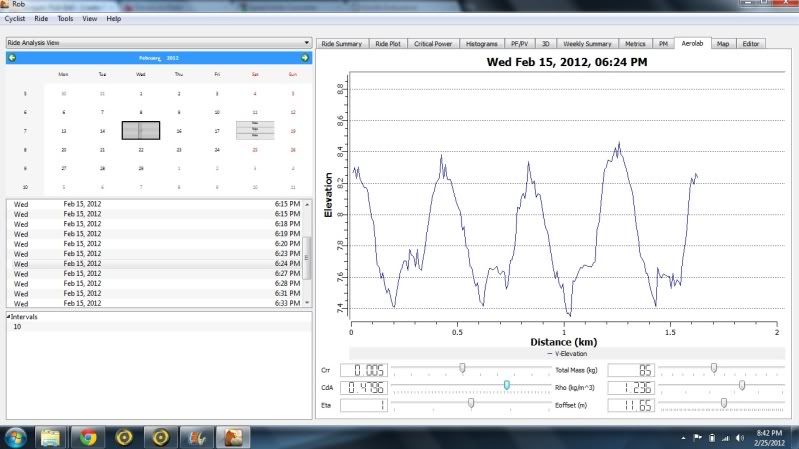A local athlete made Gorilla Endurance, which can be found at http://gorillaendurance.com/. The big benefit of this app is that it has performance management charts that track ATL, CTL, and help predict when you'll be at your peak fitness and form.
The other program I use is called Golden Cheetah. It has a pretty good combination of features including a performance management chart, but it is a little more quirky. The interface, especially for the ride plot, isn't very attractive.
I think the coolest feature has to be Aerolab, a way to figure out how aerodynamic one bike setup is compared to another. You can check bike fit, tire rolling resistance, and whether one aero helmet is faster than another.
With the neverending Oklahoma wind, the data tends to be a little fuzzy, but I can repeatedly get results within 1 watt of each other, most of the time within 2/10 of a watt.
Here is how it works: Whenever your power rises, your speed should rise as well. If it doesn't, it either means you are going up hill or you are getting hit with more wind. You are supposed to test on a calm day, so we'll assume that when your power rises and speed does not increase, you are going up hill. When your power drops but your speed increases you are going down hill. Golden Cheetah draws a line that should simulate the elevation profile of the route you did. If the line doesn't look right, you adjust the slider bars until it does.
On any one ride (in a short period of time with no weather changes), most of the sliders should remain constant. If you didn't change tires, the CRR (coefficient of rolling resistance) will stay the same. Your weight will stay the same. Your eta and eoffset (based on your elevation) should stay the same. The rho (weather dependent) will stay the same as long as the weather stayed pretty much constant. This just leaves your cda (coefficient of drag) as the only independent variable.
I test on a very small flat loop. The loop has a white line I can follow to make sure each lap is exactly like the one before. It is completely exposed to the wind, so the results are a bit more fuzzy, but the wind is pretty consistent. It also makes it easy to see each lap. On a perfect day without win, each peak and valley would be exactly the same. Even on this fuzzy data, having the first peak at the highest or the last peak at it's highest only gives a different of a half of a watt. Is it accurate enough to tell whether your mouth is open or closed? No. But it is accurate enough to tell you if one elbow position is faster than another.

Most of the results I've seen have been common sense stuff. For example, the lower my front end was, the more aerodynamic I was. It wasn't rocket science.
There were two things that really shocked me. One was arm pad width. The most narrow position was the fastest...as was expected. Surprisingly, the middle position was slower than the out most position. I went back and forth three times because I didn't believe it, but the results were constant each time. It's one of those things where they "eyeball wind tunnel" which is usually pretty accurate was incorrect.
The second surprise was that an aluminum Roval wheel (not a deep section wheel) with a conti tire (GP4000S with chili compound) was significantly faster than a cheap 50mm carbon rim with a conti sprinter (chili compound, not the gatorskin version). It's one reason why I really don't encourage people to buy cheap carbon wheels off ebay. They look really cool, but your stock wheels (especially if you have a tarmac pro with roval wheels) might be even faster.

it's amazing the amount of brain power and technology that people are applying, and how cheaply it is available to end-users. -Bill in Houston
ReplyDeletewhat is the difference in the rim profiles?
ReplyDeletewhy would you compare a conti sprinter to a gp4000. Those two tires are not anywhere close to the same. Rolling resistance on a sprinter is terrible, I wouldn't use them for training unless it was all solo on debri filled roads. To say its the wheel,and not change the tire is remarkable for one studying this stuff so close.
ReplyDeleteDavid A.
I've written an Aerolab user guide, available in the training section of the timetrialing forum.
ReplyDeleteDo you have a link to that? I just found this from google and don't know what timetrial forum you're talking about here.
DeleteThanks!